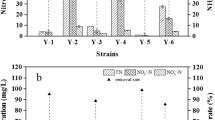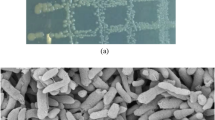Abstract
In this study, the heterotrophic nitrification–aerobic denitrification activity of Pseudomonas aeruginosa (P-1) strain was investigated, and the N transformation pathway was revealed. The highest removal rates of NH4+, NO3−, and NO2− (9.29, 6.12, and 3.72 mg L−1 h−1, respectively) by this strain were higher than those by most reported bacteria and were achieved when the carbon source was glucose, C/N ratio was 15, pH was 8, temperature was 30 °C, and shaking speed was 200 rpm. The removal order and characteristics of three N sources were investigated in Pseudomonas aeruginosa for the first time. The results revealed that P-1 preferentially nitrified NH4+ and only began to denitrify NO2− and NO3− when NH4+ was almost entirely depleted. Isotopic labeling of N sources revealed that P-1 uses both partial and complete nitrification/denitrification pathways that can operate either simultaneously or independently, depending on the availability of different types of N compounds, with N2 as the final gaseous product and virtually no NO2− accumulation. Moreover, the P-1 strain could convert various nitrogen compounds under high salinity (40 g L−1) and high concentrations of Cu2+, Zn2+, Cr6+, Pb2+, and Cd2+ (50 mg L−1). Therefore, P-1 could be used as an alternative of inorganic N-removal bacteria in practical applications.







Similar content being viewed by others

References
An Q, Zhao B, He Y (2012) Heterotrophic nitrification capability and its enzyme activity of Alcaligenes faecalis strain NR. Journal of Shanghai Jiaotong University 46:774–779
Bergmann DJ, Hooper AB, Klotz MG (2005) Structure and sequence conservation of Hao cluster genes of autotrophic ammonia-oxidizing bacteria: evidence for their evolutionary history. Appl Environ Microb 71:5371–5382
Chen J, Gu S, Hao H, Chen J (2016) Characteristics and metabolic pathway of Alcaligenes sp. TB for simultaneous heterotrophic nitrification-aerobic denitrification. Appl Microbiol Biot 100:9787–9794
Chen J, Zheng J, Li Y, Hao H, Chen J (2015) Characteristics of a novel thermophilic heterotrophic bacterium, Anoxybacillus contaminans HA, for nitrification-aerobic denitrification. Appl Microbiol Biot 99:10695–10702
Chen M, Wang W, Feng Y, Zhu X, Zhou H, Tan Z, Li X (2014) Impact resistance of different factors on ammonia removal by heterotrophic nitrification-aerobic denitrification bacterium Aeromonas sp HN-02. Bioresour Technol 167:456–461
Duan J, Fang H, Su B, Chen J, Lin J (2015) Characterization of a halophilic heterotrophic nitrification-aerobic denitrification bacterium and its application on treatment of saline wastewater. Bioresour Technol 179:421–428
Duan H, Gao S, Li X, Ab Hamid NH, Jiang G, Zheng M, Bai X, Bond PL, Lu X, Chislett MM, Hu S, Ye L, Yuan Z (2020) Improving wastewater management using free nitrous acid (FNA). Water Res 171:115382
Gao S, Ho JY, Fan L, Nouwens A, Hoelzle RD, Schulz B, Guo J, Zhou J, Yuan Z, Bond PL (2019) A comparative proteomic analysis of Desulfovibrio vulgaris Hildenborough in response to the antimicrobial agent free nitrous acid. Sci Total Environ 672:625–633
Gilcreas FW (1967) Future of standard methods for the examination of water and wastewater. Health Lab Sci 4:137–141
Gui M, Chen Q, Ma T, Zheng M, Ni J (2017) Effects of heavy metals on aerobic denitrification by strain Pseudomonas stutzeri PCN-1. Appl Microbiol Biot 101:1717–1727
Guo L, Zhao B, An Q, Tian M (2016) Characteristics of a novel aerobic denitrifying bacterium, Enterobacter cloacae strain HNR. Appl Biochem Biotech 178:947–959
Her JJ, Huang JS (1995) Influences of carbon surface and C/N ratio on nitrate nitrite denitrification and carbon breakthrough. Bioresour Technol 54:45–51
Hochstein LI, Betlach M, Kritikos G (1984) The effect of oxygen on denitrification during steady-state growth of Paracoccus-halodenitrificans. Arch Microbiol 137:74–78
Hu TL, Kung KT (2000) Study of heterotrophic nitrifying bacteria from wastewater treatment systems treating acrylonitrile, butadiene and styrene resin wastewater. Water Sci Technol 42:315–321
Huang G, Ou L, Pan F, Wang Y, Fan G, Liu G, Wang W (2017) Isolation of a novel heterotrophic nitrification-aerobic denitrification bacterium Serratia marcescens CL1502 from deep-sea sediment. Environ Eng Sci 34:453–459
Huang X, Li W, Zhang D, Qin W (2013) Ammonium removal by a novel oligotrophic Acinetobacter sp Y16 capable of heterotrophic nitrification-aerobic denitrification at low temperature. Bioresour Technol 146:44–50
Joo H, Hirai M, Shoda M (2005) Characteristics of ammonium removal by heterotrophic nitrification-aerobic denitrification by Alcaligenes faecalis No. 4. J Biosci Bioeng 100(2):184–191
Ka JO, Urbance J, Ye RW, Ahn TY, Tiedje JM (1997) Diversity of oxygen and N-oxide regulation of nitrite reductases in denitrifying bacteria. FEMS Microbiol Lett 156:55–60
Lei Y, Wang Y, Liu H, Xi C, Song L (2016) A novel heterotrophic nitrifying and aerobic denitrifying bacterium, Zobellella taiwanensis DN-7, can remove high-strength ammonium. Appl Microbiol Biot 100:4219–4229
Levy-Booth DJ, Prescott CE, Grayston SJ (2014) Microbial functional genes involved in nitrogen fixation, nitrification and denitrification in forest ecosystems. Soil Biol Biochem 75:11–25
Liang X, Ren YX, Yang L, Zhao SQ, Xia ZH (2015) Characteristics of nitrogen removal by a heterotrophic nitrification-aerobic denitrification bacterium YL. Huan Jing Ke Xue 36:1749–1756
Liu T, Ma B, Chen X, Ni B, Peng Y, Guo J (2017) Evaluation of mainstream nitrogen removal by simultaneous partial nitrification, anammox and denitrification (SNAD) process in a granule-based reactor. Chem Eng J 327:973–981
Medhi K, Singhal A, Chauhan DK, Thakur IS (2017) Investigating the nitrification and denitrification kinetics under aerobic and anaerobic conditions by Paracoccus denitrificans ISTOD1. Bioresour Technol 242:334–343
Otte S, Schalk J, Kuenen JG, Jetten M (1999) Hydroxylamine oxidation and subsequent nitrous oxide production by the heterotrophic ammonia oxidizer Alcaligenes faecalis. Appl Microbiol Biot 51:255–261
Ozeki S, Baba I, Takaya N, Shoun H (2014) A novel C1-using denitrifier Alcaligenes sp. STC1 and its genes for copper-containing nitrite reductase and azurin. Biosci Biotechnol Biochem 65:1206–1210
Padhi SK, Tripathy S, Mohanty S, Maiti NK (2017) Aerobic and heterotrophic nitrogen removal by Enterobacter cloacae CF-S27 with efficient utilization of hydroxylamine. Bioresour Technol 232:285–296
Qiu X, Wang T, Zhong X, Du G, Chen J (2012) Screening and characterization of an aerobic nitrifying-denitrifying bacterium from activated sludge. Biotechnol Bioproc E 17:353–360
Ren Y, Yang L, Liang X (2014) The characteristics of a novel heterotrophic nitrifying and aerobic denitrifying bacterium, Acinetobacter junii YB. Bioresour Technol 171:1–9
Robertson LA, van Niel EW, Torremans RA, Kuenen JG (1988) Simultaneous nitrification and denitrification in aerobic chemostat cultures of Thiosphaera pantotropha. Appl Environ Microbiol 54:2812–2818
Sun Y, Li A, Zhang X, Ma F (2015) Regulation of dissolved oxygen from accumulated nitrite during the heterotrophic nitrification and aerobic denitrification of Pseudomonas stutzeri T13. Appl Microbiol Biot 99:3243–3248
Takaya N, Catalan-Sakairi M, Sakaguchi Y, Kato I, Zhou ZM, Shoun H (2003) Aerobic denitrifying bacteria that produce low levels of nitrous oxide. Appl Environ Microb 69:3152–3157
Vyrides I, Stuckey DC (2009) Adaptation of anaerobic biomass to saline conditions: role of compatible solutes and extracellular polysaccharides. Enzyme Microb Tech 44:46–51
Wang J, Gong B, Huang W, Wang Y, Zhou J (2017) Bacterial community structure in simultaneous nitrification, denitrification and organic matter removal process treating saline mustard tuber wastewater as revealed by 16S rRNA sequencing. Bioresour Technol 228:31–38
Wang T, Dang Q, Liu C, Yan J, Fan B, Cha D, Yin Y, Zhang Y (2016) Heterotrophic nitrogen removal by a newly-isolated alkalitolerant microorganism, Serratia marcescens W5. Bioresour Technol 211:618–627
Wang Y, Chen H, Liu Y, Ren R, Lv Y (2015) Effect of temperature, salinity, heavy metals, ammonium concentration, pH and dissolved oxygen on ammonium removal by an aerobic nitrifier. RSC Adv 5:79988–79996
Wehrfritz JM, Reilly A, Spiro S, Richardson DJ (1993) Purification of hydroxylamine oxidase from Thiosphaera pantotropha identification of electron accepters that couple heterotrophic nitrification to aerobic denitrification. FEBS Lett 335:246–250
Wittmann C, Kim HM, John G, Heinzle E (2003) Characterization and application of an optical sensor for quantification of dissolved O2 in shake-flasks. Biotechnol Lett 25:377–380
Yang J, Wang Y, Chen H, Lyu Y (2019) Ammonium removal characteristics of an acid-resistant bacterium Acinetobacter sp. JR1 from pharmaceutical wastewater capable of heterotrophic nitrification-aerobic denitrification. Bioresour Technol 274:56–64
Yang L, Ren Y, Liang X, Zhao S, Wanga J, Xia Z (2015) Nitrogen removal characteristics of a heterotrophic nitrifier Acinetobacter junii YB and its potential application for the treatment of high-strength nitrogenous wastewater. Bioresour Technol 193:227–233
Yang M, Lu D, Qin B, Liu Q, Zhao Y, Liu H, Ma J (2018) Highly efficient nitrogen removal of a coldness-resistant and low nutrient needed bacterium, Janthinobacterium sp M-11. Bioresour Technol 256:366–373
Yang X, Wang S, Zhou L (2012) Effect of carbon source, C/N ratio, nitrate and dissolved oxygen concentration on nitrite and ammonium production from denitrification process by Pseudomonas stutzeri D6. Bioresour Technol 104:65–72
Yildiz HY, Benli A (2004) Nitrite toxicity to crayfish, Astacus leptodactylus, the effects of sublethal nitrite exposure on hemolymph nitrite, total hemocyte counts, and hemolymph glucose. Ecotox Environ Safe 59:370–375
Young JC, Clesceri LS, Kamhawy SM (2007) Changes in the biochemical oxygen demand procedure in the 21st edition of standard methods for the examination of water and wastewater - closure. Water Environ Res 79:455–456
Zhang Q, Liu Y, Ai G, Miao L, Zheng H, Liu Z (2012) The characteristics of a novel heterotrophic nitrification-aerobic denitrification bacterium, Bacillus methylotrophicus strain L7. Bioresour Technol 108:35–44
Zhao B, He YL, Huang J, Taylor S, Hughes J (2010) Heterotrophic nitrogen removal by Providencia rettgeri strain YL. J Ind Microbiol Biot 37:609–616
Zhao B, Tian M, An Q, Ye J, Guo JS (2017) Characteristics of a heterotrophic nitrogen removal bacterium and its potential application on treatment of ammonium-rich wastewater. Bioresour Technol 226:46–54
Zheng M, Li C, Liu S, Gui M, Ni J (2016) Potential application of aerobic denitrifying bacterium Pseudomonas aeruginosa PCN-2 in nitrogen oxides (NOx) removal from flue gas. J Hazard Mater 318:571–578
Funding
This work was supported by Wenzhou Science and Technology major project (grant number ZS2017001), Basic public welfare research projects in Zhejiang Province (grant number LGF18E090007,; and the National Natural Science Foundation of China (grant numbers 41877114, 41907219, 31670008, 31870005).
Author information
Authors and Affiliations
Corresponding author
Ethics declarations
Conflict of interests
The authors declare that they have no conflict of interest.
Additional information
Responsible Editor: Gerald Thouand
Publisher’s note
Springer Nature remains neutral with regard to jurisdictional claims in published maps and institutional affiliations.
Highlights
• Nitrification of NH4+ occurred prior to denitrification of NO2− and NO3−.
• Pseudomonas aeruginosa P-1 performed well under salt and heavy metal ion stresses.
• In NH4+, NO2−, and NO3− transformations, the final gaseous product was N2.
• The N transformation pathway was determined by the nitrogen source substrate type.
Rights and permissions
About this article
Cite this article
Wei, R., Hui, C., Zhang, Y. et al. Nitrogen removal characteristics and predicted conversion pathways of a heterotrophic nitrification–aerobic denitrification bacterium, Pseudomonas aeruginosa P-1. Environ Sci Pollut Res 28, 7503–7514 (2021). https://doi.org/10.1007/s11356-020-11066-7
Received:
Accepted:
Published:
Issue Date:
DOI: https://doi.org/10.1007/s11356-020-11066-7



